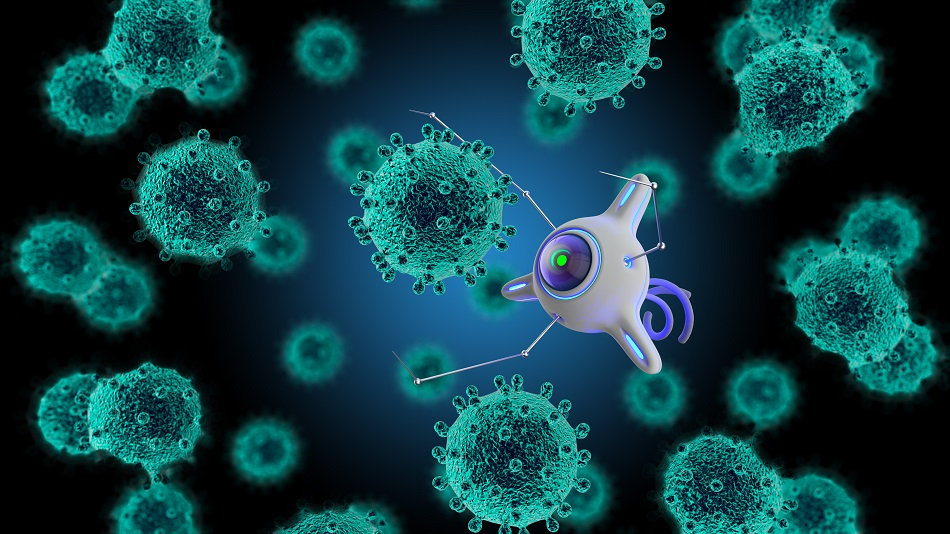Feb 5 2020

Image Credit: Volodymyr Horbovyy/Shutterstock.com
In 1984, Stanislaw Lem, a Polish writer penned down ‘Pokój na Ziemi’, a sci-fi novel later translated in English as ‘Peace on Earth’. In it, Lem describes bacteria sized robots collectively looking like normal dust developed by artificial intelligence on the moon in an era of global cold warfare. These tiny robots are later sent to earth to destroy all technology, weapons, and machines but leaving the living organisms intact. They penetrated cannon barrels, tanks, planes, and any kind of metal.
Our literature and movies are full of descriptions of such tiny and synthetic robots. Keanu Reeves starred in “The day the earth stood still” showcasing similar self-replicating tiny robots via “GORT”, an alien robot, sent to Earth by a superior intelligent alien species. Are these dust-like robots confined to fiction? After the introduction of nanotechnology in the late twentieth century, we have imagined the realization of such nanorobots in both arts and engineering. So, have we progressed in realizing this dream, or is it too ambitious?? In this article, we’ll try to figure out the world of “Nanobots”, robots that work on the nanoparticle scale.
Firstly, nanobots are synthetic robots that are capable of performing operations or processes at nanoscales (i.e. 10-9 meters). These are fundamentally different from micro-scaled robots in terms of scales of operations and materials but have resemblances in design and control techniques. Due to progress in the development of fabrication techniques, much higher resolutions for fabrications can be created.
Advancements in nanotechnology, molecular engineering, and material synthesis enabled us to use the bottom-up approach to realize these functional nanobots. The breakthrough expected from these robots is in the field of diagnostics and medicine. Nanoscaled robots can work on many tasks, especially at sub 100 nm scales and specially designed robots are employed for diagnostics. These nanobots can easily move through the bloodstream due to their size. These nanobots are functionalized with fluorescent biomolecules that are highly biospecific. These fluorescent molecules bind to the molecules to be detected and generate a strong signal. Thus, specific toxins, enzymes, microbes, etc. can be detected with extremely high efficiency compared to conventional diagnostic tools.
It also lowers the price since there is no need for bulky and expensive commercial diagnostic machines. K. Eric Drexler in 1986, had the idea of injecting nanobots into the bloodstream for medical applications. Robert A. Freitas conceptualized these nanobots and categorized them as follows:
1. Respirocytes (Artificial Synthetic Red Blood Cells)
Respirocytes were designed for transporting oxygen and carbon dioxide inside the human body. These artificial RBCs are spheres of roughly 1-micron diameter. It can store around 3 billion oxygen and carbon dioxide molecules throughout the body which is more than 200 times the capacity of a normal red blood cell. In lung capillaries, the respirocyte exchanges the two gasses controlled by an onboard nanocomputer. It can also be programmed to scavenge harmful gasses like carbon monoxide from the bloodstream.
2. Microbivores (Artificial Synthetic White Blood Cells)
Microbivores were designed to function as artificial white blood cells and thus are also known as phagocytes. These artificial WBCs are ellipsoids of about 3.4-micron length along the major axis and 2-micron length along the minor axis. Microbivores mainly trap pathogens and microbes in the bloodstream and disintegrate them by a process called phagocytosis. A microbivore mainly consists of four components. A binding site for the pathogens, an array of telescoping grapples, a morcellation chamber, and a digestion chamber.
3. Clottocyte (Artificial Synthetic Platelets)
When tissue is physically damaged causing the rupture of endothelium cells of blood vessels, platelets provide the clotting (scientifically known as hemostasis) of blood. The whole process of hemostasis can take about 2-5 minutes. At the time of the rupture of the blood vessel, it’s very important to stop the bleeding to avoid loss of life. A clottocyte is a theoretical nanobot shaped like a sphere of roughly 2-micron diameter. It has an accelerated hemostasis response and can achieve the state in about 1 second. The response time is approximately 100-1000 times faster than the normal hemostasis process.
Advantages of Robots that Can Work at Nanoscales
- The nanobots can be designed and programmed so that they are capable of targeted drug delivery and diagnostics. Only the malignant cells are attacked and treated, leaving healthy cells in the close vicinity of the attack site intact.
- It reduces the complexities involved in the surgical procedures since these nanobots can reach parts of the human anatomy that are not easily operable on an operating table.
- The accuracy is increased multiple times since these nanobots are functionalized with highly biospecific molecules capable of interaction with specific species.
- The rate and quantity of drug delivery can be monitored in real-time. The dosage can be changed depending on the response and biofeedback.
- It’s capable of high-cost effectiveness by minimizing the use of bulky and expensive diagnostic and guiding tools. If mass-produced by batch fabrication, it can scale up the healthcare even in the most remote parts of the world.
- Due to its minimal invasiveness, post-treatment care is less compared to conventional medical techniques.
Considering the severe effects and challenges caused by conventional medical treatments, robots capable of working at a nanometer scale are highly desirable for further development in modern medicine and healthcare. Especially in the field of medical diagnosis, nanobots can be employed for improved efficiency and accuracy. It can replace both diagnostic and drug delivery processes altogether, resulting in a much higher rate of medical success with cost-effective tools. It may also enable medicine to reach the most remote parts of the world since the operating systems are not that bulky thus realizing the dream of global accessible healthcare. We will be able to see these nanobots employed in daily medical purposes very soon as elementary trials are already underway.
Sources and Further Reading